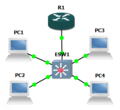Basic computer network components
Computer networks share common devices, functions, and features including servers, clients, transmission media, shared data, shared printers and other hardware and software resources, network interface card(NIC), local operating system(LOS), and the network operating system (NOS).





Servers - Servers are computers that hold shared files, programs, and the network operating system. Servers provide access to network resources to all the users of the network. There are many different kinds of servers, and one server can provide several functions. For example, there are file servers, print servers, mail servers, communication servers, database servers, fax servers and web servers, to name a few. Sometimes it is also called host computer, servers are powerful computer that store data or application and connect to resources that are shared by the user of a network.
Clients - Clients are computers that access and use the network and shared network resources. Client computers are basically the customers(users) of the network, as they request and receive services from the servers. These days, it is typical for a client to be a personal computer that the users also use for their own non-network applications.
Transmission Media - Transmission media are the facilities used to interconnect computers in a network, such as twisted-pair wire, coaxial cable, and optical fiber cable. Transmission media are sometimes called transmission medium channels, links or lines.
Shared data - Shared data are data that file servers provide to clients such as data files, printer access programs and e-mail.
Shared printers and other peripherals - Shared printers and peripherals are hardware resources provided to the users of the network by servers. Resources provided include data files, printers, software, or any other items used by clients on the network.
Network Interface Card - Each computer in a network has a special expansion card called a network interface card (NIC). The NIC prepares(formats) and sends data, receives data, and controls data flow between the computer and the network. On the transmit side, the NIC passes frames of data on to the physical layer, which transmits the data to the physical link. On the receiver's side, the NIC processes bits received from the physical layer and processes the message based on its contents.
Local Operating System - A local operating system allows personal computers to access files, print to a local printer, and have and use one or more disk and CD drives that are located on the computer. Examples are MS-DOS, Unix, Linux, Windows 2000, Windows 98, Windows XP etc. The network operating system is the software of the network. It serves a similar purpose that the OS serves in a stand-alone computer
Network Operating System - The network operating system is a program that runs on computers and servers that allows the computers to communicate over the network.
Hub - Hub is a device that splits a network connection into multiple computers. It is like a distribution center. When a computer requests information from a network or a specific computer, it sends the request to the hub through a cable. The hub will receive the request and transmit it to the entire network. Each computer in the network should then figure out whether the broadcast data is for them or not.
Switch - Switch is a telecommunication device grouped as one of computer network components. Switch is like a Hub but built in with advanced features. It uses physical device addresses in each incoming messages so that it can deliver the message to the right destination or port.
Unlike a hub, switch doesn't broadcast the received message to entire network, rather before sending it checks to which system or port should the message be sent. In other words, switch connects the source and destination directly which increases the speed of the network. Both switch and hub have common features: Multiple RJ-45 ports, power supply and connection lights.
Router - When we talk about computer network components, the other device that used to connect a LAN with an internet connection is called Router. When you have two distinct networks (LANs) or want to share a single internet connection to multiple computers, we use a Router. In most cases, recent routers also include a switch which in other words can be used as a switch. You don’t need to buy both switch and router, particularly if you are installing small business and home networks. There are two types of Router: wired and wireless. The choice depends on your physical office/home setting, speed and cost.
LAN Cable A local area Network cable is also known as data cable or Ethernet cable which is a wired cable used to connect a device to the internet or to other devices like computer, printers, etc.